
THE GREAT GATSBY: NOW (AND THEN) A MAJOR MOTION PICTURE
By Robert S. Birchard
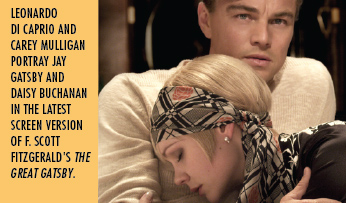 For a novel that sold poorly on its 1925 publication, F. Scott Fitzgerald's "The Great Gatsby" has enjoyed a remarkable afterlife. Although narrator Nick Carraway warned the self-fashioned and ever-optimistic Jay Gatsby (née Jimmy Gatz), "You can't relive the past," Gatsby responded, "Of course you can, Old Sport," and filmmakers have "...beat on, boats against the current, borne back ceaselessly into the past," to prove Carraway wrong.
For a novel that sold poorly on its 1925 publication, F. Scott Fitzgerald's "The Great Gatsby" has enjoyed a remarkable afterlife. Although narrator Nick Carraway warned the self-fashioned and ever-optimistic Jay Gatsby (née Jimmy Gatz), "You can't relive the past," Gatsby responded, "Of course you can, Old Sport," and filmmakers have "...beat on, boats against the current, borne back ceaselessly into the past," to prove Carraway wrong.
"The Great Gatsby" has inspired four big screen translations – in 1926, 1949 and 1974 and now in 2013 by director Baz Luhrmann, as well as TV outings in 1955, 1958, 1999 and 2000, and even a 1926 Broadway play, not to mention a 2011 short called THE GREAT GATSBY IN FIVE MINUTES, which inexplicably has a running time twice that long.
Adapted to suit the exigencies of the times, the movie incarnations have shifted Gatsby's time-frame from the novel's 1922 to 1925 to 1926, to an amorphous 1928 with 1940s fashions and 1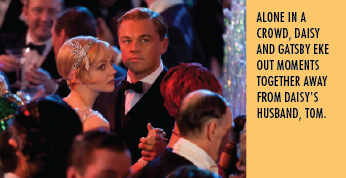 930s cars. The latest Warner Bros. version offers a mashed-up 1922 Art Deco fantasy world where moderne fashion and geometric architecture are ubiquitous some three years before 1925's Paris Exposition Internationale des Arts Décoratifs et Industriels Modernes brought these stylings to wide public attention, while the 1920s foxtrots co-exist with the 1960s rock classic, "Happy Together."
930s cars. The latest Warner Bros. version offers a mashed-up 1922 Art Deco fantasy world where moderne fashion and geometric architecture are ubiquitous some three years before 1925's Paris Exposition Internationale des Arts Décoratifs et Industriels Modernes brought these stylings to wide public attention, while the 1920s foxtrots co-exist with the 1960s rock classic, "Happy Together."
Leonardo DiCaprio is the Gatsby for our time in the screen's latest version of Fitzgerald's work, echoing past roles like the optimistic Jack Dawson in TITANIC, the elusive Howard Hughes of THE AVIATOR, and the self-deluded Teddy Daniels from SHUTTER ISLAND.
Tobey Maguire assumes the role of Nick Carraway this go-around—no longer wearing Spider-Man's disguise, but observing Gatsby's world through the mask of an outsider. Carey Mulligan is Daisy, the peaches and cream object of Gatsby's desire to travel back to a time when their love was new and uncomplicated by the intrusion of reality.
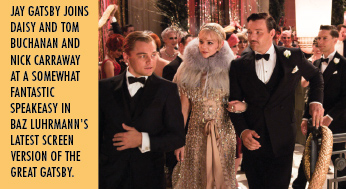
Luhrmann brings the "jukebox musical" sensibility he pursed with great effect in his films MOULIN ROUGE and ROMEO & JULIET to THE GREAT GATSBY's gossamer plot. Undoubtedly, no matter how unorthodox his approach, Luhrmann will capture the outward trappings of Fitzgerald's tale in this day and age at least as successfully as earlier filmmakers did in theirs. Whether he has captured the elusive philosophical essence of "The Great Gatsby" on screen remains to be seen.
Click here for a preview of the latest Great Gatsby.
GATSBY ON THE SILENT SCREEN
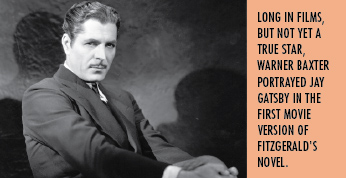 The first screen adaptation of "The Great Gatsby," released by Paramount in 1926, was not just set in the 1920s, it was made in that decade, and therefore more authentic in period detail and costuming than any subsequent version, although the backdrop was removed from the recent past of 1922 and updated to the present of 1926. It is likely we'll never know how well this film caught the novel's psychological essence, because it is one of the 78% of American silent feature films that are no longer known to exist – the victim of neglect and nitrate film decomposition.
The first screen adaptation of "The Great Gatsby," released by Paramount in 1926, was not just set in the 1920s, it was made in that decade, and therefore more authentic in period detail and costuming than any subsequent version, although the backdrop was removed from the recent past of 1922 and updated to the present of 1926. It is likely we'll never know how well this film caught the novel's psychological essence, because it is one of the 78% of American silent feature films that are no longer known to exist – the victim of neglect and nitrate film decomposition.
The few remaining outtakes that were incorporated into the film's coming attraction trailer, which can be seen here, offer only the merest glimpse of the production. There are enough fascinating elements, however, to make one wish the film might be found in some foreign archive or squirreled away in a long-neglected basement or garage.
 Jay Gatsby was played by Warner Baxter, then a leading man best described as a "working actor" and not yet the now-eclipsed superstar he would become in the early 1930s. Baxter excelled in playing world-weary characters pursuing unattainable dreams in films like 42ND STREET (1933) and TO MARY – WITH LOVE (1936), and THE GREAT GATSBY helped establish this persona in the public imagination.
Jay Gatsby was played by Warner Baxter, then a leading man best described as a "working actor" and not yet the now-eclipsed superstar he would become in the early 1930s. Baxter excelled in playing world-weary characters pursuing unattainable dreams in films like 42ND STREET (1933) and TO MARY – WITH LOVE (1936), and THE GREAT GATSBY helped establish this persona in the public imagination.
Nick Carraway was portrayed by Neil Hamilton when he was still a fresh-faced leading man and not the fusty character actor remembered for playing Commissioner Gordon in the campy 1960s TV series, BATMAN. The role of Daisy was awarded to Lois Wilson – a sensible leading lady rather than a glamorous star. This artistic approach would be echoed in the 1949 remake, one that is true to the Midwestern origins of the characters in Fitzgerald's novel.
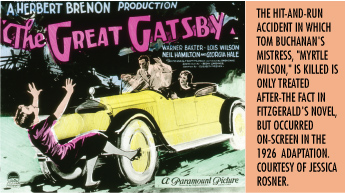 The film might have been a natural choice for director Cecil B. DeMille in his pre-epic social comedy period; but DeMille left Paramount to form his own company in 1925, and the Gatsby megaphone was handed to Herbert Brenon who was not a great visual stylist, but who could elicit fine performances from actors, as seen in surviving films like PETER PAN (1924), DANCING MOTHERS (1926) and BEAU GESTE (1927).
The film might have been a natural choice for director Cecil B. DeMille in his pre-epic social comedy period; but DeMille left Paramount to form his own company in 1925, and the Gatsby megaphone was handed to Herbert Brenon who was not a great visual stylist, but who could elicit fine performances from actors, as seen in surviving films like PETER PAN (1924), DANCING MOTHERS (1926) and BEAU GESTE (1927).
One of the more intriguing revisions in this silent film is that the character of Gatsby's unsavory mentor and business associate, Meyer Wolfsheim, who is the object of scorn by the upper-crust society Gatsby seeks to attain, was given a slightly WASPish and potentially less offensive makeover and renamed Charles Wolf. Equally intriguing is the fact that William Powell – the screen's dapper and witty gentleman rogue of the 1930s – was still in his villain/weasel period, and played the part of garage owner George Wilson.
Click here for the AFI Catalog entry for the 1926 version of The Great Gatsby.
GATSBY POST-CODE
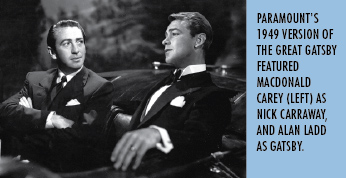 The most curious film version of "The Great Gatsby" is the 1949 remake starring Alan Ladd. It takes great liberties with the novel, trading Fitzgerald's lyricism and ambiguity for lurid melodrama and "nail-on-the-head" plotting, and yet the film remains remarkably true to the author's original intentions – at least until the arrival of a Production Code inspired (and required) moralistic wrap-up that turns 20-year-old cask-aged whiskey into Muscatel wine aged-in-the-bottle for no more than 30 minutes.
The most curious film version of "The Great Gatsby" is the 1949 remake starring Alan Ladd. It takes great liberties with the novel, trading Fitzgerald's lyricism and ambiguity for lurid melodrama and "nail-on-the-head" plotting, and yet the film remains remarkably true to the author's original intentions – at least until the arrival of a Production Code inspired (and required) moralistic wrap-up that turns 20-year-old cask-aged whiskey into Muscatel wine aged-in-the-bottle for no more than 30 minutes.
F. Scott Fitzgerald was yesterday's news by the late 1930s – a washed up relic from the "Jazz Age" he had named. But the posthumous 1941 publication of Fitzgerald's unfinished novel "The Last Tycoon" led to a reappraisal; and in 1948 Charles Scribner's Sons reissued a single volume reprinting "The Last Tycoon" along with "The Great Gatsby" and several of the author's short stories. Since Paramount already owned the screen rights to the newly popular "Gatsby," a remake seemed in order. However, in the days before television allowed the past to live inside the present by reviving old movies, the popular culture of the 1920s seemed incredibly remote and inaccessible. Paramount updated the time of the story from 1922 to 1928 – the last year of the "Jazz Age" before the Wall Street crash, moved Nick Carraway's reminiscence about Gatsby from only three years before to some 20 years earlier with an awkward prologue set at Gatsby's grave circa 1948, in which the character of Jordan Baker, now married to Carraway, also returns to the cemetery – although in the novel only Nick Carraway and Gatsby's father attended the funeral.
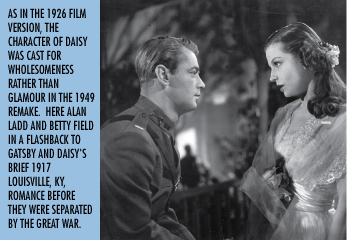 In the prologue, Carraway explains high-flying 1920s abandon to 1940s audiences chastened by the Great Depression and World War II. While Fitzgerald's novel and other film adaptations only allude to Gatsby's connection with organized crime, here Gatsby is clearly revealed to be a gangster. Other curious revisions include turning Klipspringer, Gatsby's never-leaving houseguest, into a lifelong friend and bodyguard played by Elisha Cook, Jr. in a manner reminiscent of his role as gun-toting Wilmer Cook in THE MALTESE FALCON (1941). Once again the Jewish character Meyer Wolfsheim has his ethnic wings clipped to become Myron Lupus, played by Irish-American Ed Begley. But the most obvious turn from Fitzgerald's vision is in the last-reel spiritual conversions by the leading characters. Although Tom and Daisy Buchanan still abandon Jay Gatsby, Daisy refuses to stay with Tom unless he calls to warn his rival that George Wilson is out to kill him. When Tom calls, Gatsby hears the phone but refuses to pick it up and instead reveals to Nick Carraway that he is abandoning decadence and turning over a new leaf. For all the moral revisionism, however, Alan Ladd is a nearly perfect Gatsby, exhibiting great charm as well as the vulnerability tinged with sadism that brought him to stardom in his introductory screen role as Philip Raven in THIS GUN FOR HIRE (1942).
In the prologue, Carraway explains high-flying 1920s abandon to 1940s audiences chastened by the Great Depression and World War II. While Fitzgerald's novel and other film adaptations only allude to Gatsby's connection with organized crime, here Gatsby is clearly revealed to be a gangster. Other curious revisions include turning Klipspringer, Gatsby's never-leaving houseguest, into a lifelong friend and bodyguard played by Elisha Cook, Jr. in a manner reminiscent of his role as gun-toting Wilmer Cook in THE MALTESE FALCON (1941). Once again the Jewish character Meyer Wolfsheim has his ethnic wings clipped to become Myron Lupus, played by Irish-American Ed Begley. But the most obvious turn from Fitzgerald's vision is in the last-reel spiritual conversions by the leading characters. Although Tom and Daisy Buchanan still abandon Jay Gatsby, Daisy refuses to stay with Tom unless he calls to warn his rival that George Wilson is out to kill him. When Tom calls, Gatsby hears the phone but refuses to pick it up and instead reveals to Nick Carraway that he is abandoning decadence and turning over a new leaf. For all the moral revisionism, however, Alan Ladd is a nearly perfect Gatsby, exhibiting great charm as well as the vulnerability tinged with sadism that brought him to stardom in his introductory screen role as Philip Raven in THIS GUN FOR HIRE (1942).
Click here for the AFI Catalog entry for the 1949 version of The Great Gatsby.
"REMEMBRANCE OF THINGS PAST IS NOT NECESSARILY REMEMBRANCE OF THINGS AS THEY WERE." – Marcel Proust
 Although he is best known as a film director, it is often overlooked that Francis Ford Coppola is also one of the great screenwriters of his generation. His adaptation of F. Scott Fitzgerald's "The Great Gatsby" was the most faithful to date, and the few new scenes he contributed credibly mimic the novelist's ear for believable but somewhat idealized dialogue even as they flesh out the characters. Likewise, Robert Redford and Mia Farrow were ideal choices to play Gatsby and Daisy, and the film was widely touted and highly anticipated before its March 1974 release. The December 1973 issue of Vogue magazine went so far as to claim that THE GREAT GATSBY remake had "caused the greatest pre-production excitement since GONE WITH THE WIND. So what went wrong?
Although he is best known as a film director, it is often overlooked that Francis Ford Coppola is also one of the great screenwriters of his generation. His adaptation of F. Scott Fitzgerald's "The Great Gatsby" was the most faithful to date, and the few new scenes he contributed credibly mimic the novelist's ear for believable but somewhat idealized dialogue even as they flesh out the characters. Likewise, Robert Redford and Mia Farrow were ideal choices to play Gatsby and Daisy, and the film was widely touted and highly anticipated before its March 1974 release. The December 1973 issue of Vogue magazine went so far as to claim that THE GREAT GATSBY remake had "caused the greatest pre-production excitement since GONE WITH THE WIND. So what went wrong?
Director Jack Clayton staged the action behind a veil of gauzy nostalgia that seemed to remove any real life sense of urgency from the story, and the actors treated Fitzgerald's language as holy writ—intoned in hushed yet stentorian tones. Where Fitzgerald's words that made it to the screen in the 1949 version often crackled with energy; that same dialogue in 1974 seemed unconvincing and oddly unreal, as if uttered with the last gasp of escaping air from a nearly flat tire. 
By the time the film was released, New York Times reviewer Vincent Canby found this latest Gatsby to be "lifeless without being much fun," while Jay Cocks in Time magazine noted that it is "faithful to the letter of F. Scott Fitzgerald's novel but entirely misses the point." Despite these criticisms, however, the 1974 Gatsby performed respectably at the box-office.
For the first time the character name Meyer Wolfsheim is retained from the novel, and in a piece of stunt casting the role is played by Howard Da Silva, who appeared as George Wilson in the 1949 version. The year in which the story takes place is moved to 1925 – supposedly because "there were more interesting fashions," according to the film's Oscar®-winning costume designer, Theoni V. Aldredge. The film's costumes did have a vivid, if short-lived, impact on the fashion world as bell-bottom trousers and love beads gave way to "The Gatsby Look" among hipsters for a time.
One authentic connection to actual 1920s popular culture was the use of "Crooning Troubadour" Nick Lucas, who reprised the song "When You And I Were Seventeen" several times in the film's soundtrack. Lucas gained fame for singing "Tip-Toe Through the Tulips" in the 1929 Warner Bros. musical GOLD DIGGERS OF BROADWAY.
The AFI Catalog entry for the 1974 version of The Great Gatsby is here.
When Warner Bros.' THE GREAT GATSBY arrives at a theater near you on May 10, the question will be: Is Baz Luhrmann's visualization a GATSBY for our time, or a GATSBY for all time?
Robert S. Birchard is the Editor of the AFI Catalog of Feature Films, an award-winning film editor and author of "Cecil B. DeMille's Hollywood," "Silent-era Filmmaking in Santa Barbara" and "King Cowboy: Tom Mix and the Movies."
|
|
|
|
|
